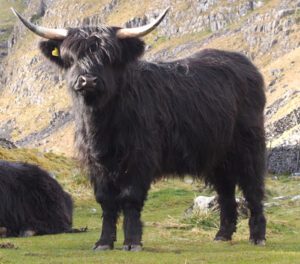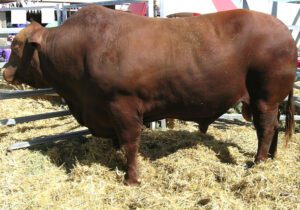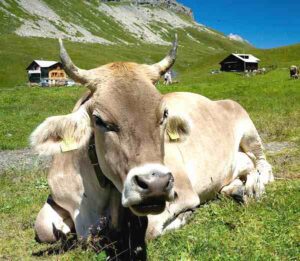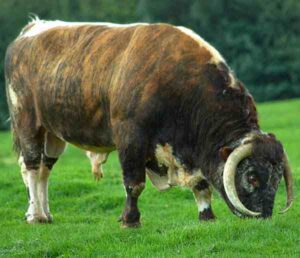The Maremmana cattle are extraordinarily robust breed of cattle which are reared in the Maremma, a former marshland region in southern Tuscany and northern Lazio in central Italy.
They are principally raised in the provinces of Grosseto, Rome and Viterbo. Exact origins of the Maremmana cattle are entirely unknown.
Some sources suggest that the breed descends from the Bos taurus macrocerus of which archeological evidence is preserved in the Etruscan remains of Caere and Vetulonia.
Others suggest that the Maremmana breed is a direct descendant of those Asiatic grey cattle (white others still maintain that the breed descends directly from the aurochs, Bos primigenius primigenius).
Large herds of the Maremmana cattle were raised in the malarial marshlands of the Maremma for centuries. And they were herded by the butteri, the mounted herdsmen of the region.
Previously, they were mainly used as a dual purpose animal and were raised for the production of beef and as a draught breed. But due to the mechanization of agriculture after the Second World War, total number of these animals decreased rapidly.
A total of 157,387 animals were recorded in 1956. But the number decreased to a total of 8812 animals in 2006.
A herdbook for the breed was opened in 1935. There were a total of 9801 animals recorded in the herd book at the end of 2012. Read some more information about the Maremmana cattle breed below.
Maremmana Cattle Characteristics
Maremmana cattle are medium sized animals generally with grey color. The cows are lighter and the bulls are darker than the cows, especially on the foreparts. They have black nose and black skin.
Their hooves, muzzle, switch and lower part of the scrotum are black. The calves are born wheat-coloured and become grey at about three months old.
Both bulls and cows have horns, and their horns are robust. The bulls have long and open-lyre horns, while the cows have cresent shaped horns.
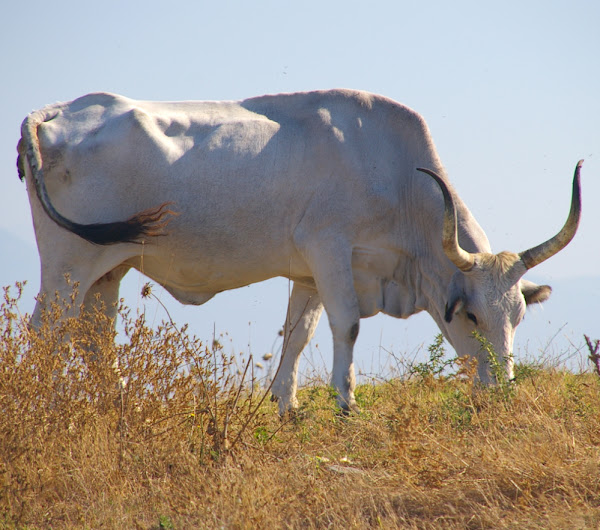
Horns of the Maremmana cattle are slate-grey in young animals, and become whitish with black tips in adulthood. Average body height of the bulls is about 150-155 cm, and 143-150 cm for the cows.
Average live body weight of the bulls vary from 850 to 1000 kg. And the cows on average weight between 550 and 650 kg. Photo and info from Wikipedia.
Uses
The Maremmana cattle were previously used as a draught animal, principally in agriculture and forestry. But today the breed is primarily raised for meat production purpose. The cows are also pretty good for producing enough milk for the calves.
Special Notes
The Maremmana cattle are extraordinarily robust breed of cattle. They are very strong and hardy animals. The cows have a well-shaped udder and is pretty good for supplying enough milk for the calves.
They are very long lived animals that can reach an age of 15-16 years. They are very good and well known for the production of flavorful and wholesome meat.
The breed is listed in the Italian Slow Food Ark of Taste. Review full breed profile of the Maremmana cattle in the following chart.
| Breed Name | Maremmana | |
| Other Name | None | |
| Breed Purpose | Meat and draft | |
| Special Notes | Strong, hardy, powerful, docile | |
| Breed Size | Medium | |
| Bulls | 850-1000 kg | |
| Cows | 550-650 kg | |
| Climate Tolerance | All Climates | |
| Coat Color | Grey (lighter in cows and darker in bulls) | |
| Horned | Yes | |
| Milk Yield | Average | |
| Rarity | Common | |
| Country/Place of Origin | Italy |


